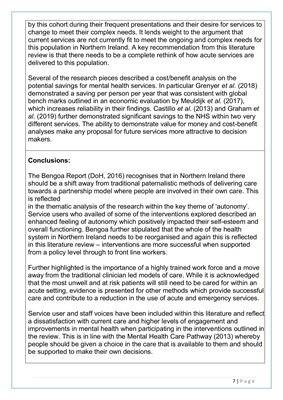
7 | P a g e
by this cohort during their frequent presentations and their desire for services to
change to meet their complex needs. It lends weight to the argument that
current services are not currently fit to meet the ongoing and complex needs for
this population in Northern Ireland. A key recommendation from this literature
review is that there needs to be a complete rethink of how acute services are
delivered to this population.
Several of the research pieces described a cost/benefit analysis on the
potential savings for mental health services. In particular Grenyer et al. (2018)
demonstrated a saving per person per year that was consistent with global
bench marks outlined in an economic evaluation by Meuldijk et al. (2017),
which increases reliability in their findings. Castillo et al. (2013) and Graham et
al. (2019) further demonstrated significant savings to the NHS within two very
different services. The ability to demonstrate value for money and cost-benefit
analyses make any proposal for future services more attractive to decision
makers.
Conclusions:
The Bengoa Report (DoH, 2016) recognises that in Northern Ireland there
should be a shift away from traditional paternalistic methods of delivering care
towards a partnership model where people are involved in their own care. This
is reflected
in the thematic analysis of the research within the key theme of 'autonomy'.
Service users who availed of some of the interventions explored described an
enhanced feeling of autonomy which positively impacted their self-esteem and
overall functioning. Bengoa further stipulated that the whole of the health
system in Northern Ireland needs to be reorganised and again this is reflected
in this literature review - interventions are more successful when supported
from a policy level through to front line workers.
Further highlighted is the importance of a highly trained work force and a move
away from the traditional clinician led models of care. While it is acknowledged
that the most unwell and at risk patients will still need to be cared for within an
acute setting, evidence is presented for other methods which provide successful
care and contribute to a reduction in the use of acute and emergency services.
Service user and staff voices have been included within this literature and reflect
a dissatisfaction with current care and higher levels of engagement and
improvements in mental health when participating in the interventions outlined in
the review. This is in line with the Mental Health Care Pathway (2013) whereby
people should be given a choice in the care that is available to them and should
be supported to make their own decisions.